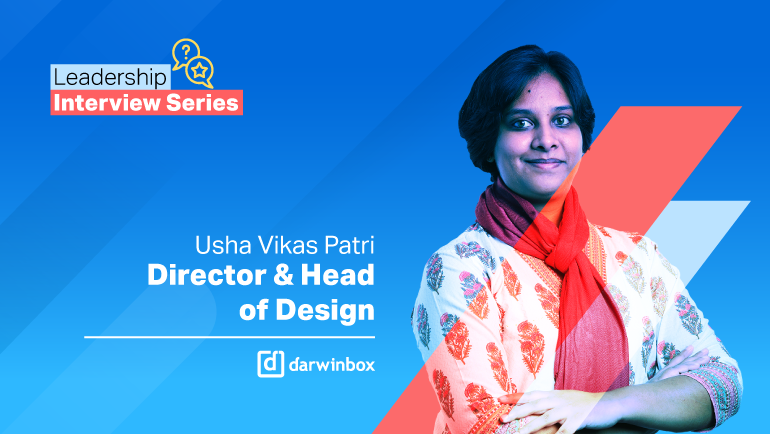

User Experience or UX, as it is popularly known, is table-stakes for all software, tools, and apps today. It is what sets the tone of the relationship between the user and the tool. What determines the success or the failure of the tool to create mindshare. And while a lot of people claim to know the craft to design enhanced user experiences, a few actually make magic happen.
Usha Vikas Patri, Director and Head of Design at Darwinbox, belongs to the latter, elite group of magicians. With 17+ years of experience in various leadership positions held at organizations like Salesforce, Innominds, Kony, Oracle, and Cognizant, she has been instrumental in transforming the contribution of design and UX.
We got in a candid conversation with her to find out the real deal on UX, her role and vision for Darwinbox’s product design, and everything in between.
Here are the excerpts:
Darwinbox: What’s your take on Employee Experience? What is the role of UX in EX?
Usha: Employee Experience is about clearly defining the journey and various touchpoints of the employee with the employer. Over the years, the interaction between employees and the employer has evolved drastically. Particularly, post covid-19 when the world of work transformed from an in-person office environment to a virtual, dispersed, and distributed workplace almost overnight. And the only thing that connected everyone was technology in its various avatars.
The common denominator and the singular success metric for businesses, as they first survived and then thrived, was user adoption of the new tech tools. So, be it external-facing tools to aid customer experiences (CX) or internal tools to facilitate employee interactions, collaborations, and management, at its heart was, is, and continues to be User Experience.
UX is about keeping the user in the front and center and defining experiences around it. It’s about having a singular obsession with people and their interaction with the product, their environment, and the people around them. Quite simply, UX needs to be at the heart of EX!
So, in order to strengthen EX, designing a great user experience then becomes supercritical. And that can only happen by ensuring we are thinking about our end-user – the employee.
Darwinbox: You have worked with some leading, global cloud platforms like Salesforce, Oracle, and Kony. What common design thinking principles did you take away from your experiences there that you would like to employ at Darwinbox?
Usha: At most of these organizations, I was instrumental in putting design and UX on the key agenda for the company; from being a part of a larger department to being identified as a separate vertical, commanding a voice in the C-suite. So, as you can imagine the takeaways were in multitude and at every juncture. Each experience helped me uncover aspects of design thinking in a way that has stuck with me and chiseled my understanding of the UX space. Here are some principles I swear by:
Get the basics right. It cannot get simpler than that. The first step and often the biggest challenge is to identify the RIGHT problem to solve. It is common to get lost in trying to solve the wrong problem and wasting valuable time and resources. It is important to first define the objective that we want to achieve.
The next critical stage is to understand the end-users. One of the most prominent steps in the UCD- User-Centered Design process is understanding and empathizing with the end-users. The more we understand the users, learn about their pain points, needs & wants, the better products/ services & experiences we can design for them.
The final step is weaving the story and crafting the journey for the users to achieve their goals.
So, we must answer WHAT we are trying to achieve or solve, WHY we are trying to solve that problem as in what is the impact we want to create. And then, figure out the HOW.
Darwinbox: What is your vision for Darwinbox from a UX standpoint? What are your key design tenets and goals?
Usha: HRMS is the only enterprise software that touches every employee in an organization, all the way from rank to file. On this continuum are individuals with varying levels of digital exposure, dexterity, and need. Now consider the fact that employees spend a good chunk of their day devoted to work. This necessitates the HR tool to have a good UX that aids adoption, use, and stickiness.
Darwinbox actually cements this relationship between the employer and the employee by delivering a product that is intuitive, efficiently automated, and easy to use. It’s been our aim since the company’s inception and continues to be one of the key priorities for the product team.
From a pure UX standpoint, my vision is to make the product more enjoyable, more user-friendly, and more cutting-edge. And because UX and user expectations (and behaviors) are dynamic and ever-evolving, the product design needs to be a living, breathing thing rather than a one-and-done process. Aligning to the product roadmap, building the right team and constant course correction will be key.
Darwinbox: Where do you find inspiration?
Usha: People. (Laughs). I love observing people’s behaviors and how they interact with their physical, environmental, and digital spaces. How products and services influence their actions and behaviors and how their actions further inform product and service companies. Watching this cycle is fascinating.
Taking this inspiration, I try to use design to bring greater alignment between the business and user needs using technology. In this new world of work, if businesses have to deliver value to their customers and increase product adoption, strengthening UX is key. In fact, I would go as far as to say, it has become the company’s lifeline.
Darwinbox: If you had to author a book on UI/ UX, what would the title be and why?
Usha: (Chuckles) I would call it, “Dealing with Ambiguity”.
Although design is quantifiable, most of the time, it remains subjective. I cannot generalize my experiences and say - follow this framework because design is contextual. Hence, it would only be fair if instead, I shared my journey in design and what methods I applied in my tenure – some of which worked and some that didn’t.
Honestly, one of the best experiences I have had in various companies is making sense of the chaos and bringing some method to madness!
If you want to hear more from people working in various areas, check this space for our full collection of interviews.



Speak Your Mind